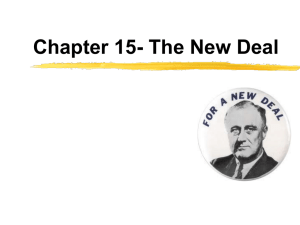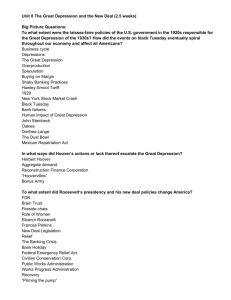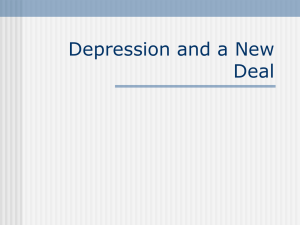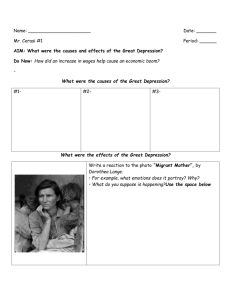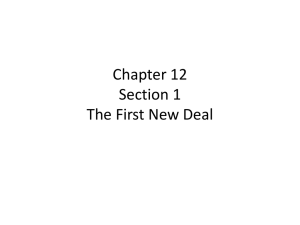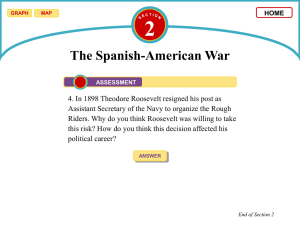essay+notes-The Great Depression and the New Deal
advertisement
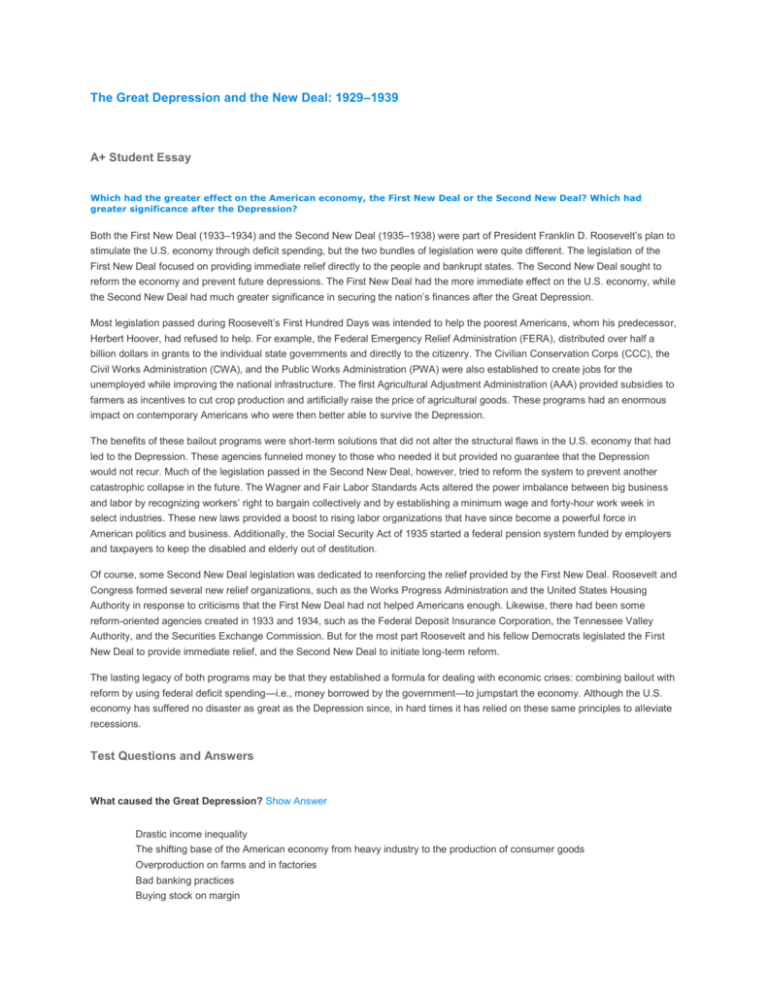
The Great Depression and the New Deal: 1929–1939 A+ Student Essay Which had the greater effect on the American economy, the First New Deal or the Second New Deal? Which had greater significance after the Depression? Both the First New Deal (1933–1934) and the Second New Deal (1935–1938) were part of President Franklin D. Roosevelt’s plan to stimulate the U.S. economy through deficit spending, but the two bundles of legislation were quite different. The legislation of the First New Deal focused on providing immediate relief directly to the people and bankrupt states. The Second New Deal sought to reform the economy and prevent future depressions. The First New Deal had the more immediate effect on the U.S. economy, while the Second New Deal had much greater significance in securing the nation’s finances after the Great Depression. Most legislation passed during Roosevelt’s First Hundred Days was intended to help the poorest Americans, whom his predecessor, Herbert Hoover, had refused to help. For example, the Federal Emergency Relief Administration (FERA), distributed over half a billion dollars in grants to the individual state governments and directly to the citizenry. The Civilian Conservation Corps (CCC), the Civil Works Administration (CWA), and the Public Works Administration (PWA) were also established to create jobs for the unemployed while improving the national infrastructure. The first Agricultural Adjustment Administration (AAA) provided subsidies to farmers as incentives to cut crop production and artificially raise the price of agricultural goods. These programs had an enormous impact on contemporary Americans who were then better able to survive the Depression. The benefits of these bailout programs were short-term solutions that did not alter the structural flaws in the U.S. economy that had led to the Depression. These agencies funneled money to those who needed it but provided no guarantee that the Depression would not recur. Much of the legislation passed in the Second New Deal, however, tried to reform the system to prevent another catastrophic collapse in the future. The Wagner and Fair Labor Standards Acts altered the power imbalance between big business and labor by recognizing workers’ right to bargain collectively and by establishing a minimum wage and forty-hour work week in select industries. These new laws provided a boost to rising labor organizations that have since become a powerful force in American politics and business. Additionally, the Social Security Act of 1935 started a federal pension system funded by employers and taxpayers to keep the disabled and elderly out of destitution. Of course, some Second New Deal legislation was dedicated to reenforcing the relief provided by the First New Deal. Roosevelt and Congress formed several new relief organizations, such as the Works Progress Administration and the United States Housing Authority in response to criticisms that the First New Deal had not helped Americans enough. Likewise, there had been some reform-oriented agencies created in 1933 and 1934, such as the Federal Deposit Insurance Corporation, the Tennessee Valley Authority, and the Securities Exchange Commission. But for the most part Roosevelt and his fellow Democrats legislated the First New Deal to provide immediate relief, and the Second New Deal to initiate long-term reform. The lasting legacy of both programs may be that they established a formula for dealing with economic crises: combining bailout with reform by using federal deficit spending—i.e., money borrowed by the government—to jumpstart the economy. Although the U.S. economy has suffered no disaster as great as the Depression since, in hard times it has relied on these same principles to alleviate recessions. Test Questions and Answers What caused the Great Depression? Show Answer Drastic income inequality The shifting base of the American economy from heavy industry to the production of consumer goods Overproduction on farms and in factories Bad banking practices Buying stock on margin Defaulted loans in Britain and France How did the New Deal tackle the Depression? Show Answer It provided immediate relief to the neediest Americans via programs like the Federal Emergency Relief Administration (FERA), the Civil Works Administration (CWA), the Public Works Administration (PWA), and the Works Progress Administration (WPA). It provided long-term recovery via programs like the Tennessee Valley Authority (TVA) and the National Industrial Recovery Administration (NIRA). It made long-term reforms to prevent another depression from occurring in the future with the Glass-Steagall Act, the Indian Reorganization Act, and the Fair Labor Standards Act. How did the New Deal affect the banking and financial sectors of the economy? Show Answer The national bank holiday temporarily closed all banks to slow the bank crisis and give banks a chance to reopen on solid footing. The Emergency Banking Relief Act gave Roosevelt the power to regulate banking transactions and foreign exchange. The Glass-Steagall Banking Reform Act of 1933 protected individuals’ savings deposits by creating the Federal Deposit Insurance Corporation (FDIC). Roosevelt took the nation off the Gold Standard. Roosevelt also created the Securities Exchange Commission to monitor trading on the stock markets. Why did some Americans attack the New Deal? Show Answer Conservatives like Al Smith claimed that the New Deal subverted American capitalism. Socialists like Huey P. Long, Charles Coughlin, and Francis E. Townsend argued that the New Deal didn’t do enough to change Wall Street, address income inequality, or help the poorest Americans. Why did the New Deal end? Show Answer The Supreme Court began to strike down several key pieces of the First New Deal like the Agricultural Adjustment Administration (AAA) and the National Industrial Recovery Act (NIRA). Roosevelt tried to “pack” the Supreme Court with pro-New Deal justices. The “Roosevelt Recession” caused by prematurely cutting back deficit spending. Republicans gained seats in the House and Senate in the 1938 midterm elections. Congress passed the Hatch Act in 1939 to severely restrict Roosevelt’s power. The Great Depression and the New Deal: 1929–1939 Timeline The stock market crashes. 1929 1930 Congress passes the Hawley-Smoot Tariff. 1932 The Reconstruction Finance Corporation is created. The Bonus Army camps in Washington, D.C. Franklin D. Roosevelt is elected president. 1933 First Hundred Days • Emergency Banking Relief Act • Civilian Conservation Corps • Federal Emergency Relief Administration • Agricultural Adjustment Administration • Tennessee Valley Authority • National Industrial Recovery Act • Public Works Administration The Twenty-First Amendment is ratified (repealing the Eighteenth Amendment). 1934 Congress passes the Indian Reorganization Act. Roosevelt creates the Security Exchange Commission. 1935 Second New Deal • Emergency Relief Appropriations Act • W. P. A. • Social Security Act • National Labor Relations Act • Resettlement Administration • National Housing Act The Committee for Industrial Organization (CIO) is created. The Supreme Court ruled on Schecter v. United States. 1936 Roosevelt is reelected. The Supreme Court ruled on Butler v. United States. 1937 Roosevelt tries to “pack” the Supreme Court. The Roosevelt Recession begins. 1938 The CIO becomes the independent Congress of Industrial Organization. 1939 Congress passes the Hatch Act.

